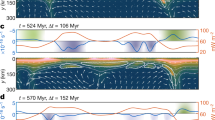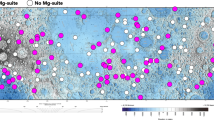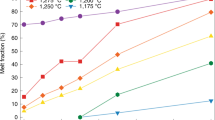Abstract
The global geodynamic regime of early Earth, which operated before the onset of plate tectonics, remains contentious. As geological and geochemical data suggest hotter Archean mantle temperature1,2 and more intense juvenile magmatism than in the present-day Earth3,4, two crust–mantle interaction modes differing in melt eruption efficiency have been proposed: the Io-like heat-pipe tectonics regime dominated by volcanism5,6 and the “Plutonic squishy lid” tectonics regime governed by intrusive magmatism, which is thought to apply to the dynamics of Venus7,8,9. Both tectonics regimes are capable of producing primordial tonalite–trondhjemite–granodiorite (TTG) continental crust5,10 but lithospheric geotherms and crust production rates as well as proportions of various TTG compositions differ greatly9,10, which implies that the heat-pipe and Plutonic squishy lid hypotheses can be tested using natural data11. Here we investigate the creation of primordial TTG-like continental crust using self-consistent numerical models of global thermochemical convection associated with magmatic processes. We show that the volcanism-dominated heat-pipe tectonics model results in cold crustal geotherms and is not able to produce Earth-like primordial continental crust. In contrast, the Plutonic squishy lid tectonics regime dominated by intrusive magmatism results in hotter crustal geotherms and is capable of reproducing the observed proportions of various TTG rocks. Using a systematic parameter study, we show that the typical modern eruption efficiency of less than 40 per cent12 leads to the production of the expected amounts of the three main primordial crustal compositions previously reported from field data4,11 (low-, medium- and high-pressure TTG). Our study thus suggests that the pre-plate-tectonics Archean Earth operated globally in the Plutonic squishy lid regime rather than in an Io-like heat-pipe regime.
This is a preview of subscription content, access via your institution
Access options
Access Nature and 54 other Nature Portfolio journals
Get Nature+, our best-value online-access subscription
$29.99 / 30 days
cancel any time
Subscribe to this journal
Receive 51 print issues and online access
$199.00 per year
only $3.90 per issue
Buy this article
- Purchase on Springer Link
- Instant access to full article PDF
Prices may be subject to local taxes which are calculated during checkout



Similar content being viewed by others
References
Herzberg, C. & Gazel, E. Petrological evidence for secular cooling in mantle plumes. Nature 458, 619–622 (2009)
Condie, K., Aster, R. & van Hunen, J. A great thermal divergence in the mantle beginning 2.5 Ga: geochemical constraints from greenstone basalts and komatiites. Geosci. Frontiers 7, 543–553 (2016)
Condie, K. Accretionary orogens in space and time. Geol. Soc. Am. 200, 145–158 (2007)
Dhuime, B., Hawkesworth, C., Cawood, P. & Storey, C. A change in the geodynamics of continental growth 3 billion years ago. Science 335, 1334–1336 (2012)
Moore, W. & Webb, A. Heat-pipe earth. Nature 501, 501–505 (2013)
Johnson, T., Brown, M., Kaus, B. & VanTongeren, J. Delamination and recycling of Archaean crust caused by gravitational instabilities. Nat. Geosci. 7, 47–52 (2014)
Van Kranendonk, M. Two types of Archean continental crust: plume and plate tectonics on early earth. Am. J. Sci. 310, 1187–1209 (2010)
Gerya, T., Stern, R., Baes, M., Sobolev, S. & Whattam, S. Plate tectonics on the Earth triggered by plume-induced subduction initiation. Nature 527, 221–225 (2015)
Fischer, R. & Gerya, T. Early earth plume-lid tectonics: a high-resolution 3d numerical modelling approach. J. Geodyn. 100, 198–214 (2016)
Sizova, E., Gerya, T., Stüwe, K. & Brown, M. Generation of felsic crust in the Archean: a geodynamic modeling perspective. Precambr. Res. 271, 198–224 (2015)
Moyen, J. The composite Archaean grey gneisses: petrological significance, and evidence for a non-unique tectonic setting for Archaean crustal growth. Lithos 123, 21–36 (2011)
Crisp, J. A. Rates of magma emplacement and volcanic output. J. Volcanol. Geotherm. Res. 20, 177–211 (1984)
Benn, K ., Mareschal, J.-C . & Condie, K. in Archean Geodynamics and Environments (eds Benn, K ., Mareschal, J.-C . & Condie, K. ) 1–5 (AGU, 2006)
Gerya, T. Precambrian geodynamics: concepts and models. Gondwana Res. 25, 442–463 (2014)
Rey, P., Coltice, N. & Flament, N. Spreading continents kick-started plate tectonics. Nature 513, 405–408 (2014)
Bédard, J. A catalytic delamination-driven model for coupled genesis of Archaean crust and sub-continental lithospheric mantle. Geochim. Cosmochim. Acta 70, 1188–1214 (2006)
de Smet, J., van den Berg, A. & Vlaar, N. The evolution of continental roots in numerical thermo-chemical mantle convection models including differentiation by partial melting. Lithos 48, 153–170 (1999)
Lourenço, D., Rozel, A. & Tackley, P. Melting-induced crustal production helps plate tectonics on earth-like planets. Earth Planet. Sci. Lett. 439, 18–28 (2016)
Tackley, P. J. Self consistent generation of tectonic plates in time-dependent, three dimensional mantle convection simulations. Part 1: pseudoplastic yielding. Geochem. Geosyst. Geophys. 1, 1026 (2000)
Byerlee, J. Friction of rocks. Pure Appl. Geophys. 116, 615–626 (1978)
Strom, R., Schaber, G. & Dawson, D. The global resurfacing of Venus. J. Geophys. Res. 99, 10899–10926 (1994)
Armann, M. & Tackley, P. Simulating the thermochemical magmatic and tectonic evolution of Venus’s mantle and lithosphere: two-dimensional models. J. Geophys. Res. 117, E12003 (2012)
Tackley, P. J. Modelling compressible mantle convection with large viscosity contrasts in a three-dimensional spherical shell using the yin-yang grid. Phys. Earth Planet. Inter. 171, 7–18 (2008)
Hernlund, J. W. & Tackley, P. J. Modeling mantle convection in the spherical annulus. Phys. Earth Planet. Inter. 171, 48–54 (2008)
Amestoy, P ., Duff, I . & l’Excellent, J.-Y. Multifrontal parallel distributed symmetric and unsymmetric solvers. Comput. Methods Appl. Mech. Eng. 184, 501–520 (2000)
Harlow, F. & Welch, J. Numerical calculation of time-dependent viscous incompressible flow of fluid with a free surface. Phys. Fluids 8, 2182 (1965)
Nakagawa, T. & Tackley, P. Thermo-chemical structure in the mantle arising from a three-component convective system and implications for geochemistry. Phys. Earth Planet. Inter. 146, 125–138 (2004)
Nakagawa, T. & Tackley, P. Influence of magmatism on mantle cooling, surface heat flow and Urey ratio. Earth Planet. Sci. Lett. 329/330, 1–10 (2012)
Karato, S.-I. & Wu, P. Rheology of the upper mantle: a synthesis. Science 260, 771–778 (1993)
Yamazaki, D. & Karato, S.-I. Some mineral physics constraints on the rheology and geothermal structure of Earth’s lower mantle. Am. Mineral. 86, 385–391 (2001)
Tackley, P., Ammann, M., Brodholt, J., Dobson, D. & Valencia, D. Mantle dynamics in super-Earths: post-perovskite rheology and self-regulation of viscosity. Icarus 225, 50–61 (2013)
Cˇ ížková, H., van den Berg, A., Spakman, W. & Matyska, C. The viscosity of Earth’s lower mantle inferred from sinking speed of subducted lithosphere. Phys. Earth Planet. Inter. 200/201, 56–62 (2012)
Irifune, T. & Ringwood, A. Phase transformations in subducted oceanic crust and buoyancy relationships at depths of 600-800 km in the mantle. Earth Planet. Sci. Lett. 117, 101–110 (1993)
Ono, S., Ito, E. & Katsura, T. Mineralogy of subducted basaltic crust (MORB) from 25 to 37 GPa, and chemical heterogeneity of the lower mantle. Earth Planet. Sci. Lett. 190, 57–63 (2001)
Moyen, J.-F . & Stevens, G. in Archean Geodynamics and Environments (eds Benn, K ., Mareschal, J.-C . & Condie, K. ) 149–178 (AGU, 2006)
Van Kranendonk, M. in Earth’s Oldest Rocks (eds Kranendonk, M. V ., Smithies, R . & Bennet, V .) 1st edn, Developments in Precambrian Geology Vol. 15, 1105–1116 (Elsevier, 2007)
Nutman, A. et al. in Earth Accretionary Systems in Space and Time (eds Cawood, P. & Kröner, A. ) 1st edn, Vol. 318, 127–154 (Spec. Publ. Geol. Soc. Lond., GSL, 2009)
van Hunen, J. & Moyen, J.-F. Archean subduction: fact or fiction? Annu. Rev. Earth Planet. Sci. 40, 195–219 (2012)
Griffin, W . & O’Reilly, S. in Earth’s Oldest Rocks (eds Kranendonk, M. V ., Smithies, R . & Bennet, V. ) 1st edn, Developments in Precambrian Geology Vol. 15, Ch. 8.2, 1013–1035 (Elsevier, 2007)
Hickman, A . & Kranendonk, M. V. in The Precambrian Earth: Tempos and Events Vol. 12, 118–139 (Elsevier, 2004)
Labrosse, S ., Hernlund, J . & Hirose, K. in The Early Earth 123–142 (John Wiley & Sons, 2015)
Harris, L. & Bédard, J. in Evolution of Archean Crust and Early Life (eds Dilek, Y. & Furnes, H. ) Modern Approaches In Solid Earth Sciences Vol. 7, Ch. 9, 215–288 (Springer, 2014)
Harris, L . & Bédard, J. in Volcanism and Tectonism Across the Inner Solar System (eds Platz, T ., Massironi, M ., Byrne, P. K . & Hiesinger, H. ) Vol. 401, 327–356 (Spec. Publ. Geol. Soc. Lond., GSL, 2015)
Schaber, G. et al. Geology and distribution of impact craters on Venus: what are they telling us? J. Geophys. Res. 97, 13257–13301 (1992)
Herrick, R. Resurfacing history of Venus. Geology 22, 703–706 (1994)
McKinnon, W ., Zahnle, K ., Ivanov, B . & Melosh, H. in Venus II (eds Bougher, S ., Hunten, D . & Phillips, R. ) 969–1014 (Univ. Arizona Press, 1997)
Tackley, P. in European Geosciences Union General Assembly Conference Abstracts Vol. 17, 13804 (EGU, 2015)
Basilevsky, A. & Head, J. The surface of Venus. Rep. Prog. Phys. 66, 1699–1734 (2003)
Aittola, M. & Kostama, V.-P. Venusian novae and arachnoids: characteristics, differences and the effect of the geological environment. Planet. Space Sci. 48, 1479–1489 (2000)
Krassilnikov, A. & Head, J. Novae on Venus: geology, classification, and evolution. J. Geophys. Res. 108, 5108 (2003)
Barsukov, V. et al. Preliminary evidence on the geology of Venus from radar measurements by the Venera 15 and 16 probes. Geokhimia 12, 1811–1820 (1984)
Stofan, E. et al. Global distribution and characteristics of coronae and related features on Venus: implications for origin and relation to mantle processes. J. Geophys. Res. 97, 13347–13378 (1992)
Stofan, E., Smrekar, S., Tapper, S., Guest, J. & Grindrod, P. Preliminary analysis of an expanded corona database for Venus. Geophys. Res. Lett. 28, 4267–4270 (2001)
Grinrod, P. & Hoogenboom, T. Venus: the corona conundrum. Astron. Geophys. 47, 16–21 (2006)
Bindschadler, D . & Head, J. Tessera terrain, Venus: characterization and models for origin and evolution. J. Geophys. Res. 96, 5889–5907 (1991)
Sandwell, D. & Schubert, G. Evidence for retrograte lithosphere subduction on Venus. Science 257, 766–770 (1992)
Ernst, R., Grosfils, E. & Mége, D. Giant dike swarms: Earth, Venus, and Mars. Annu. Rev. Earth Planet. Sci. 29, 489–534 (2001)
Smrekar, S. & Stofan, E. Corona formation and heat loss on Venus by coupled upwelling and delamination. Science 277, 1289–1294 (1997)
Hoogenboom, T. & Houseman, G. Rayleigh-Taylor instability as a mechanism for corona formation on Venus. Icarus 180, 292–307 (2006)
Anderson, F. & Smrekar, S. Global mapping of crustal and lithospheric thickness on Venus. J. Geophys. Res. 111, E08006 (2006)
James, P., Zuber, M. & Phillips, R. Crustal thickness and support of topography on Venus. J. Geophys. Res. 118, 859–875 (2013)
Gerya, T. Plume-induced crustal convection: 3D thermomechanical model and implications for the origin of novae and coronae on Venus. Earth Planet. Sci. Lett. 391, 183–192 (2014)
Nutman, A. P. Antiquity of the oceans and continents. Elements 2, 4 (2006)
Acknowledgements
We thank K. Condie, L. Moresi and M. Van Kranendonk for comments and suggestions as part of the review process. A.B.R. and C.J. received funding from the European Research Council under the European Union’s Seventh Framework Programme (FP/20072013)/ERC Grant Agreement number 320639 project iGEO. T.G. received support from the SNF projects Swiss-AlpArray and number 200020_166063.
Author information
Authors and Affiliations
Contributions
A.B.R., G.J.G., C.J. and T.G. designed the set of numerical simulations. P.J.T. implemented the eruption–intrusion routines in the convection code. A.B.R. wrote all postprocessing routines and produced the figures. All authors contributed to the manuscript.
Corresponding author
Ethics declarations
Competing interests
The authors declare no competing financial interests.
Additional information
Reviewer Information Nature thanks K. Condie, L. Moresi and M. Van Kranendonk for their contribution to the peer review of this work.
Publisher's note: Springer Nature remains neutral with regard to jurisdictional claims in published maps and institutional affiliations.
Extended data figures and tables
Extended Data Figure 1 Comparison of field data (and their geodynamic interpretation) and the tectonic regimes self-consistently obtained in our simulations (see Methods).
Numerical models always show some intense deformation during the first hundreds of millions of years and then reach a stagnant phase. Massive resurfacing events (purple areas) are sometimes observed after a long stability period, consistent with field data36,63 interpretations. Ga, billions of years ago.
Source data
Rights and permissions
About this article
Cite this article
Rozel, A., Golabek, G., Jain, C. et al. Continental crust formation on early Earth controlled by intrusive magmatism. Nature 545, 332–335 (2017). https://doi.org/10.1038/nature22042
Received:
Accepted:
Published:
Issue Date:
DOI: https://doi.org/10.1038/nature22042
This article is cited by
-
Plate tectonics in the Archean: Observations versus interpretations
Science China Earth Sciences (2024)
-
Deep formation of Earth’s earliest continental crust consistent with subduction
Nature Geoscience (2023)
-
Earth’s early continental crust formed from wet and oxidizing arc magmas
Nature (2023)
-
The spirited youth of Venus
Nature Astronomy (2023)
-
I-type and S-type granites in the Earth’s earliest continental crust
Communications Earth & Environment (2023)
Comments
By submitting a comment you agree to abide by our Terms and Community Guidelines. If you find something abusive or that does not comply with our terms or guidelines please flag it as inappropriate.



